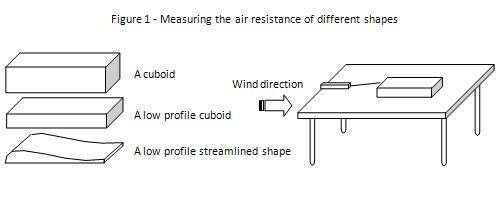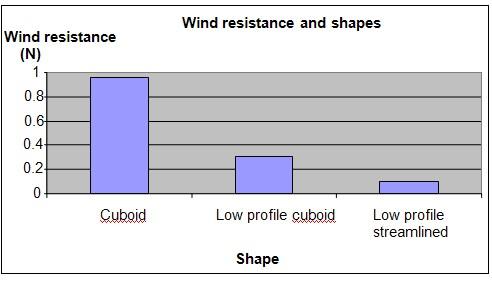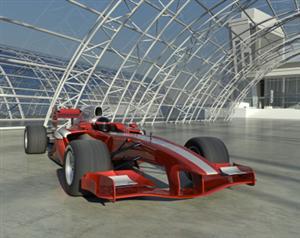| Complexity level: | 6 |
| Project cost ($): | 40 |
| Time required: | 1 day to preparation, 1 day for observation |
| Material availability: | Easily found. An industrial strength fan may be purchased at Lowes/Home Depot or other hardware stores |
| Safety concerns: | Basic safety requirements |
Hypothesis
Cars that are have low profile, streamlined shapes will experience a lower amount of wind resistance
Overview
Wind resistance
Wind resistance is a force opposing the movement of an object through the air. It is also known as drag force in fluid dynamics (namely, the forces which oppose the relative motion of the object through the fluid (be it a gas or liquid). The amount of wind resistance faced by the moving object will increase as the object moves more quickly through air.
The shape of the moving object will also determine the amount of wind resistance it experiences. A body with a flat surface, such as a cube, will experience greater wind resistance compared to a body with a pointed or streamlined shape. This is taken into consideration in the design of aircraft and automobile structures in order to reduce fuel consumption and increase speed.
When the speed of the moving vehicle increases, the wind resistance increase as well. When Interestingly, when a vehicle moves at speeds greater than 100km/hour, about 30% of the fuel consumed to propel the vehicle is used to overcome wind resistance. Hence, wind resistance is a very important factor that vehicle manufacturers take into account, when designing a vehicle.
Scientific Terms
Materials
The materials required for this science fair project are:
- 3 pieces of polyfoam – 100mm x 100mm x 200mm
- 1 paper knife
- 1 Newton spring balance
- 1 industrial fan
- 1 table with a smooth surface
- 1 nail
Procedure
1. The independent variable of this science fair project is the shape of the object – rectangular, low profile rectangular and low profile streamlined. The dependent variable is the wind resistance on the object. This is measured using the Newton spring balance. The constants (control variables) are the wind velocity, the materials used to construct the shapes (poly foam), the smoothness of the table surface and the distance of the fan from the object.
2. Using a paper knife, the following shapes are carved from the poly foam.
a. A cuboid – 100mm x 100mm x 200mm
b. A low profile cuboid – 50mm x 100mm x 200mm
c. A low profile streamlined shape – 50mm x 100mm x 200mm

3. The Newton spring balance is mounted on the side of the table using a nail. The cuboid foam cut out is fixed onto the tip of the spring balance. Place the industrial fan 1 meter away from the table. Once the fan is turned on, the wind will push thefoam cut out away from the fan. The force of the wind acting on the foam cut out can be measured using the Newton spring balance. The reading is observed and recorded in the table provided below.
4. Step 3is repeated with the low profile rectangle and the low profile streamlined foam cut outs respectively. The measurements from the Newton spring balance are recorded in the table provided below.


Results
The foam cut out with a low profile streamlined shape had the least wind resistance and the cuboid-shaped foam had the most wind resistance.
| Shape | Cuboid | Low profile cuboid | Low profile streamlined |
| Wind resistance (N) | 0.95 | 0.3 | 0.1 |
Plot the results observed into a graph, as shown below

Conclusion
The hypothesis that a low profile, streamlined aerofoil shape experiences the least wind resistance is proven to be true.
The study of fluid dynamics, aerodynamic shapes and wind resistance helps us to design and develop more fuel efficient and faster vehicles. However, a trade-off is necessary between ease of application on the one hand and fuel efficiency on the other . A low profile aerodynamically shaped vehicle may have limited passenger space. However it is ideal for race cars and fighter planes.
Also consider
The experiment may be repeated using different shapes other than the ones already used.
The science fair project can be repeated using different wind speeds. Also, do you get the same results for water resistance?
References
Fuel economy in automobiles - http://en.wikipedia.org/wiki/Fuel_economy_in_automobiles
Fuel efficient driving - http://www.eartheasy.com/live_fuel_efficient_driving.htm
Drag (physics) - http://en.wikipedia.org/wiki/Drag_ (physics)

